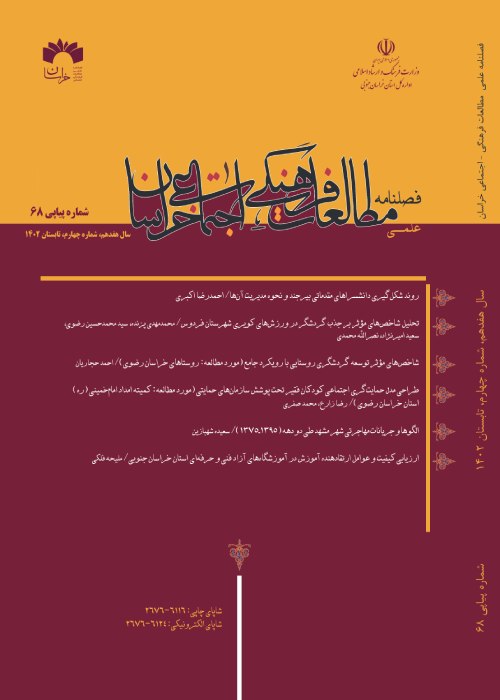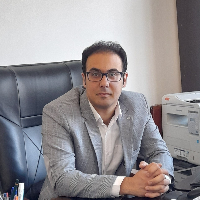Art Market’s Infrastructures and Calligraphy Artists’ Income in Mashhad
Author(s):
Article Type:
Research/Original Article (دارای رتبه معتبر)
Abstract:
Introduction
Artists, especially visual artists (such as calligraphers) tend to be self-employed and are rarely employed by an employer. The self-employed are sometimes by choice and sometimes by circumstances (no other choice); because official and stable job opportunities are not offered to artists. However, since artists sometimes work numerous jobs due to their self-employment, the topic of artists' livelihood is crucial to consider while studying the art market. In contrast to the market for art products and services, the majority of research in cultural economics have examined the artist labor market and its distinctive features. On the contrary, the present paper assesses the effect of selected infrastructures of the calligraphy art market on the artistic income among resident calligraphers in Mashhad (in which all of them are self-employed). Infrastructures (for example, roads, education, etc.) are prerequisites to superstructures (such as manufacturing, agricultural, and mining activities). Infrastructure is defined as a set of physical and institutional facilities that affect the quantitative and qualitative goods and services produced by economic agents. The infrastructures are very wide in terms of number and variety. In general, the infrastructures of art market can be categorized into six pillars: 1) institutional environment, including copyright, instability of laws and regulations of the culture sector and mixing with religion; 2) business environment including distribution system, multiple job-holding, access to external credits, membership in associations, working population, business establishment cost, years of earning degree and education cost; 3) the supply side including the cost of goods sold, profit margin, dependence on external credits, psychic income and pricing mechanism; 4) the demand side including the decrease in using calligraphy, consumer taste, purchasing power, the development of calligraphy software, the desire to buy copies and the share of government orders; 5) market structure including market type, market size and degree of monopoly; 6) access to the market including transaction costs, proximity to decision-making centers, specialized galleries, art fairs and expos.Methodology
A sample of 33 calligraphers living in Mashhad was selected, and then required data were collected using in-depth interview and a five-point Likert scale questionnaire. One- and two-way Analysis of Variance (ANOVA) methods are used. This method helps determine which of the substructures can explain the difference in income level among calligraphers. It is hard to study every aspect of the economic infrastructures due to their enormous range and diversity. As a result, an index is chosen for each of the six infrastructure areas (institutional environment, business environment, supply side, demand side, market structure, and market access) that were previously described. Therefore, the role of these infrastructures is examined on the difference in the income levels of the calligraphers in Mashhad. Empirical Findings
The findings implicate that four one-way analyses of variance (multiple job-holding, psychic income, decreasing the use of calligraphy, the share of exhibitions and expos), and four two-way variance analyses (the interaction effect of multi-job, and psychic income, the interaction effect of multiple job-holding and market level, the interaction effect of multiple job-holding and the share of exhibitions and expos, the interaction effect of market structure and instability of laws and regulations) significantly explain the difference among income levels of calligraphers. Conclusion
From these findings, three factors of higher psychic income, activity at the lower level of the market (primary market), and the lower share of exhibitions and expos in the income of calligraphers increase the need (as a result, their desire) to engage in other professions related or unrelated to art. This justifies the reason for accepting the income penalty for remaining in artistic activity. On the other hand, instability in the regulatory system of the culture sector (and more generally, the creative sector) reduces the motivation of artists to enter and develop artistic activity and the possibility of planning around education, skill acquisition, and creation. There are two basic causes for this problem. As a consequence of the proliferation of laws and regulations, there is a growing sense of uncertainty in Iran's cultural sector due to the multiplicity and separation of its primary policy-making organizations. Second, political regimes, through changes in policies and normative frameworks supported by the government, cause a continuous change in the art market. In sum, after recommending the necessary policies to increase the income of artists, as a sufficient condition for the effectiveness of these policies, this research suggests creating an integrated “mega-regulator” in the form of a single ministry for the whole creative sector in Iran.Keywords:
Language:
Persian
Published:
Scientific Quarterly of Social-Cultural Studies of Khorasan, Volume:17 Issue: 2, 2023
Pages:
7 to 36
magiran.com/p2599141
دانلود و مطالعه متن این مقاله با یکی از روشهای زیر امکان پذیر است:
اشتراک شخصی
با عضویت و پرداخت آنلاین حق اشتراک یکساله به مبلغ 1,390,000ريال میتوانید 70 عنوان مطلب دانلود کنید!
اشتراک سازمانی
به کتابخانه دانشگاه یا محل کار خود پیشنهاد کنید تا اشتراک سازمانی این پایگاه را برای دسترسی نامحدود همه کاربران به متن مطالب تهیه نمایند!
توجه!
- حق عضویت دریافتی صرف حمایت از نشریات عضو و نگهداری، تکمیل و توسعه مگیران میشود.
- پرداخت حق اشتراک و دانلود مقالات اجازه بازنشر آن در سایر رسانههای چاپی و دیجیتال را به کاربر نمیدهد.
In order to view content subscription is required
Personal subscription
Subscribe magiran.com for 70 € euros via PayPal and download 70 articles during a year.
Organization subscription
Please contact us to subscribe your university or library for unlimited access!




